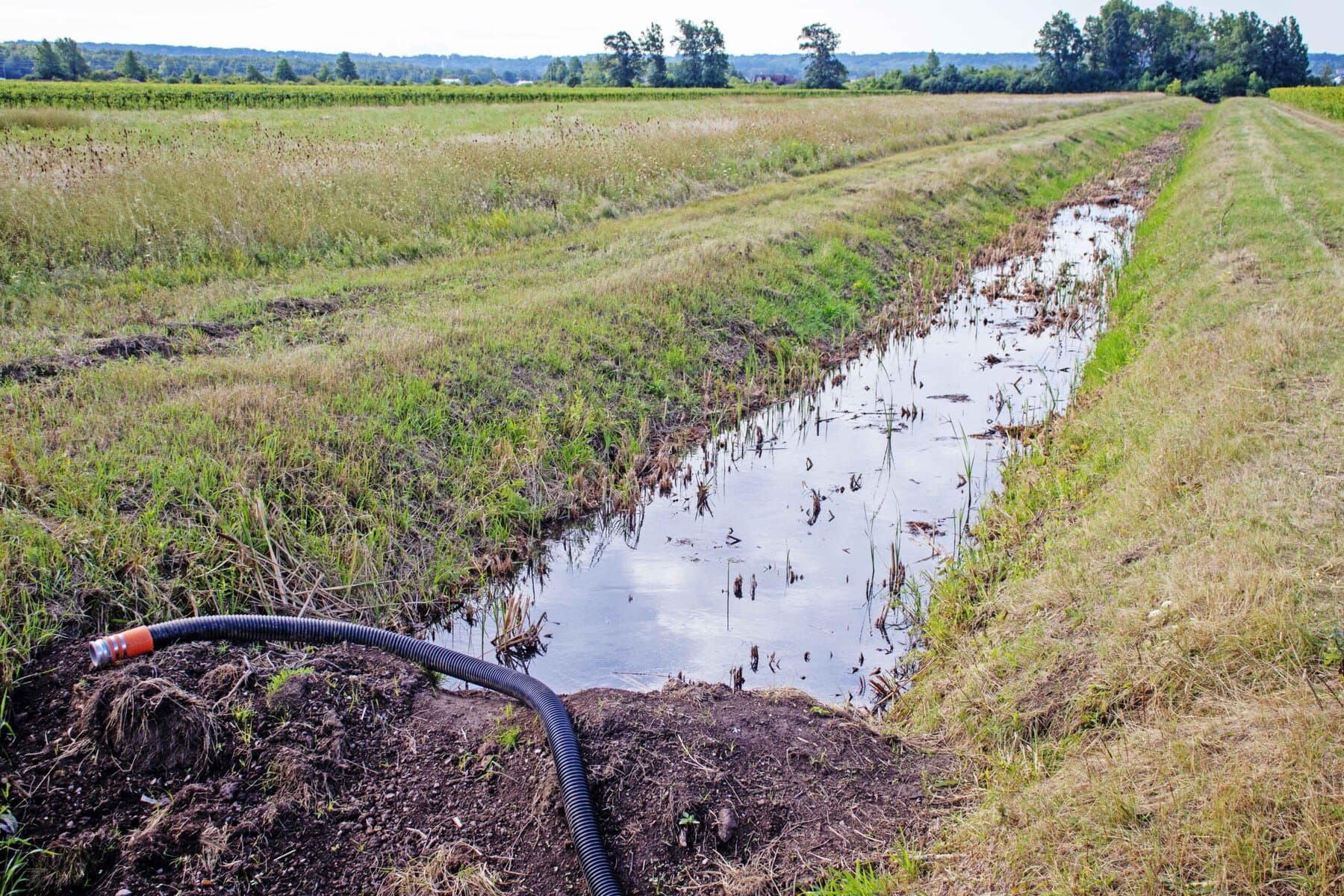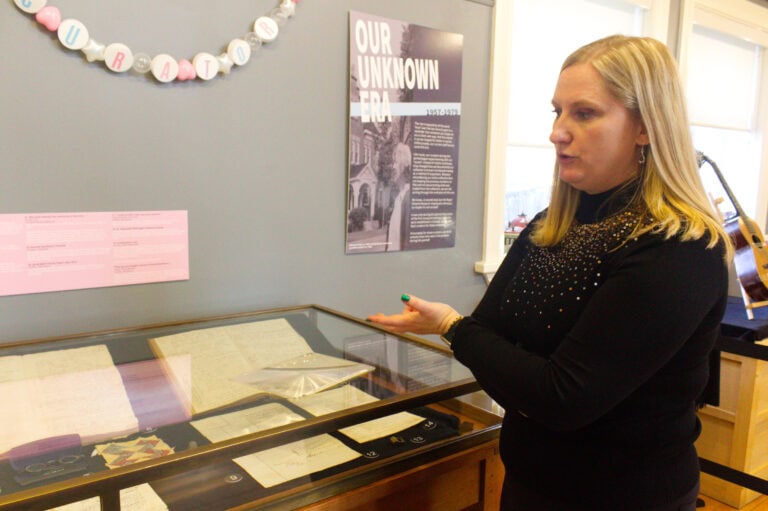The Town of Niagara-on-the-Lake is suing a local quarry company for costs related to the cleanup of the Cole Drain in 2022 following an environmental spill in NOTL’s farmlands that summer.
In a statement of claim filed with the Ontario Superior Court on Aug. 14, the town argues that Arriscraft Canada Inc., which operates the quarry located between Concession 5 and 6, is responsible for the formation of a sludge-like and putrid material in the drain, which it rushed to clean up, costing about $1.2 million.
Arriscraft denies allegations that it was responsible for the substance, which, after the town had already cleaned it up, was determined to be sulphate reducing bacteria.
The incident has resulted in a “he said, she said” scenario with the town and Arriscraft pointing fingers at the other for the liability.
The town says Arriscraft was, ultimately, responsible for the bacteria formation as a result of releasing water with a high concentration of sulphate into the drain. It says the company should reimburse the municipality for the bill.
Arriscraft claims it did not do anything that violates the standards of the Ministry of the Environment, Conservation and Parks. It argues no environmental damage was done, that it did nothing to contribute to the incident and that the town “grossly” overspent on the cleanup.
Further complicating the issue is an agreement of liability between the town and a previous owner of the quarry dating back to 1980.
The town claims the subsequent companies operating on the property are bound to the same agreement. Arriscraft argues the agreement was not transferable and that the town ultimately undertook a cleanup that was not necessary. It also argues that even if the agreement was in place, the town didn’t honour its side of it.
In a statement of claim, filed with the Ontario Superior Court on May 29, the town says water from a settling pond at the quarry, owned solely at the time by Meridian Brick Canada, Ltd., was the source of the contaminant.
Arriscraft and Meridian merged in 2023.
The cleanup
Shortly after a discharge from the settling pond on approximately Aug.16, 2022, the town received complaints about the appearance and odour coming from the Cole Drain north of the discharge point from the quarry.
“These complaints were inspected by town staff who confirmed the odour and observed a petroleum-like sheen and black sludge,” states the claim.
Believing that an upstream spill had occurred, the town contacted the Ministry of the Environment, Conservation and Parks, which sent out an officer to inspect.
The officer inspected the area and orally directed the town to clean up the material, which was then followed by a written directive from the same officer to confirm the verbal direction.
An official order to clean the site never came from the ministry itself, however.
The town then contracted GHD Limited as its environmental consultant and Accuworx Inc. to clean up the material.
Instructions from GHD called for the installation of soil berms in the drain to prevent waters from impacting Four Mile Creek, the Virgil reservoirs and Lake Ontario — water that provides a source of potable water and fish habitats.
Accurworx then “removed impacted waters from various sections of the Cole Drain into portable tanks,” said the town’s statement.
The removal of water from the drain was done on a 24/7 basis between Aug. 18 and 21.
An estimated 1.8 million litres of affected water were removed, of which approximately 1.1 million litres were shipped to a treatment facility called Moores refining.
After learning the bacteria was not hazardous, the town had the remaining water shipped to the Niagara-on-the-Lake and Port Weller sewage treatment plants.
The expense associated with this work of approximately $1.2 million.
Tests proved substance was not harmful
After testing, the town’s consultant concluded the cause of the smell and sludge-like appearance of the water in the drain was sulphate reducing bacteria — micro-organisms that use sulfur for their metabolic processes.
“We use oxygen to breathe, but the sulfur-reducing bacteria can actually use elemental sulfur and convert it to hydrogen sulphide as part of the respiration and overall growth,” Vaughn Mangal, assistant professor in the chemistry department at Brock University, told The Lake Report in October 2022.
Hydrogen sulphide is known for smelling like rotten eggs.
Mangal added there is no explicit health problem that could come from sulfur reducing bacteria.
Still, the town wants compensation for the money it spent to clean it up.
‘Sulphate-laden water’
The town argues water samples collected by its consultant revealed a high amount of sulphate in the surface water where the quarry drains into the watershed.
“The sample from the quarry discharge water from the quarry pond was higher than any sulphate concentration detected downstream and were significantly higher than would be expected in rainwater,” the town’s claim states.
“The town pleads that but for the discharge of the sulphate-laden water from the quarry, the environmental incident would not have occurred.”
The town believes that the defendant is in breach of various laws including causing damage to the Cole Drain contrary to the Drainage Act and endangering or killing fish habitats under the Fisheries Act.
Arriscraft responds
The law firm Goodmans LLP filed a statement of defence on Aug. 14 claiming its client was not responsible for the presence of the bacteria.
“Arriscraft operated its quarry in compliance with its environmental permits and all environmental laws, including the chemical limits applicable to the discharge of quarry water,” it said.
The statement added that an annual third-party review from an environmental advisory company called WSP Canada Inc. gave the company a passing grade in 2023.
That report “concluded that water discharged from the quarry in 2023 did not exceed any limits prescribed by the Environmental Compliance Approval.”
The company suggests chemicals from local farming and a lack of maintenance to the ditch could have easily caused the high concentration of the bacteria.
“Had the tall grass been cut and the previous grass cuttings been removed from the ditch then water would have flowed freely through the Cole Drain and the stagnant conditions needed for the development of the (sulphate reducing bacteria) growth would not have existed.”
The company states that it should not be held responsible for any reason and is seeking legal costs on a full indemnity basis.
Liability clause
The 1980 liability clause between the town and then-quarry owner Burnstein Brick Limited stated that if any erosion, silting, toxic or chemical damage to the drains and watercourse was caused by the company, it would then be responsible for associated repair costs.
In its defence, Arriscraft argues the clause is not applicable to them because the company, and any of its affiliates, are not a corporate successor to Burnstein Brick.
It also argues that even if the company was “somehow” still beholden to the clause, that the town didn’t act in accordance with the agreement.
The company claims that, per the agreement, in such an incident where a potential environmental contaminant gets into a watershed, the town must give the company 30 days to respond.
It says it was never given a chance to do its own investigation before the town began cleaning the spill.
The company also argues the town’s cleanup was a “grossly excessive” kneejerk reaction that could have been done at a much lower cost — and that the town should not have begun cleaning it until the substance was identified.
“There was simply no reason to send the water, at a significantly increased cost, to an industrial treatment facility.”
“If the plaintiff had waited for test results, it would have realized that the water in the Cole Drain, even if odorous, was not hazardous.”
When speaking with The Lake Report in 2022, Mangal said the town’s actions were justifiable.
“Although it might not seem like a big deal in the immediate source, it could have downstream consequences that may not be as clear that you just alleviate by cleaning it up,” he said.










